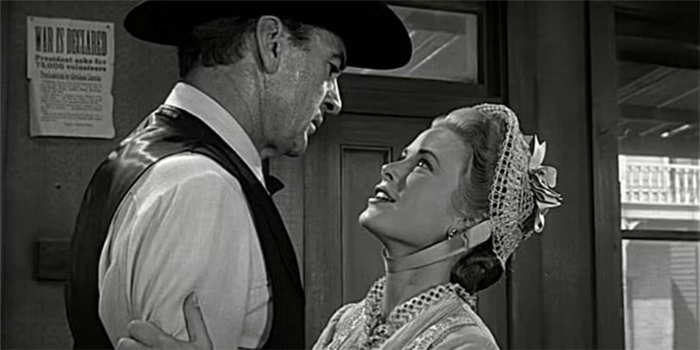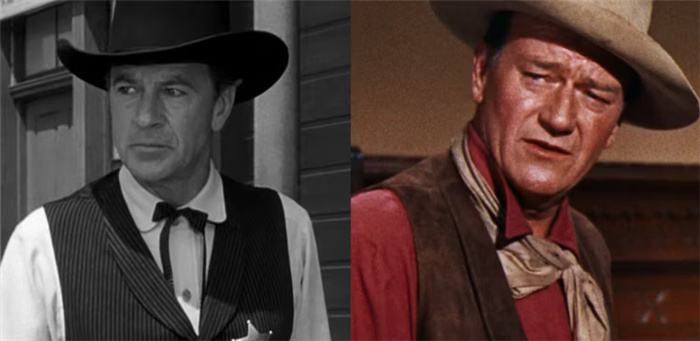To say that John Wayne was the de facto king of cinema during his heyday would be underselling just how safe and strong a box office draw the actor was. Known mostly for war movies and westerns, Wayne was also an outspoken individualist, American patriot, and conservative person, and that extended into his Hollywood activism. At the time the actor had peaked, Hollywood was thrown into the midst of McCarthyism and the Red Scare, as people were accused of having communist sympathies, often with little to no evidence.
This political witch hunt wound up targeting one of the most significant Western movies in history: High Noon. Known for its political subtext and rallying cry against apathy, the film drew criticism upon release. In a bid to hit back against the film’s themes, Wayne would later make Rio Bravo, which many see as the conservative answer to High Noon. Both films command a great deal of respect within their genre, but it begs the question of just what Wayne disliked so much about the iconic 1952 movie.
High Noon Changed The Direction Of The Western Genre
High Noon – The grand finale of the film sees the arrival of Miller who reunited with his old gang, marches through the town, brazenly opening himself up to challengers. When Kane shows up, a shootout between the Marshal and Miller’s gang ensues, one that sees the hero make a daring stand, aided by the arrival of his wife. When Will and Amy are finally successful in killing Miller, the people of Hadleyville, who had been absent from the streets, suddenly rush out to congratulate Kane — after spending the film refusing to aid him. The scene is a good criticism of the many people who refuse to aid their community or country when the chips are down, but who are eager to claim credit when things go well. Kane’s final moment sees him throw down his star and ride away with his wife, leaving the town without their famed Marshal. The scene was even echoed in Dirty Harry, a movie that borrowed elements of High Noon in its similar portrayal of law enforcement as a thankless job.
The opinion one might form of High Noon can depend on their perspective. Viewing the film as a commentary on the inaction of the American people in the face of adversity, especially in the decade after World War II, would surely leave a viewer with negative feelings. In the context many critics view it in, the film was the writing of Carl Foreman, and his plea to get Americans to wake up to the injustice of McCarthyism and the silence of people too afraid to speak up. However, seeing the movie instead as a philosophical comment on what can be achieved through unity and courage turns the film into one of the greatest hero stories of all time. It should be noted that the film is based on a short story, “The Tin Star,” written by John W. Cunningham. The story, despite being relevant to its time, has maintained an impressive, timeless message of overcoming apathy and the power of collective action.

Why John Wayne Hated High Noon
When High Noon was released, the United States was experiencing the height of McCarthyism and the “Red Scare,” a period known for government and private investigations into communist activities. This was spurred on by a combination of factors, such as the US Cold War against the USSR, the discovery of Soviet spy activity in the country, and the paranoia of Senator Joe McCarthy. The American film industry was no different, and there were bitter disputes between anti-communist activists, such as John Wayne and Ronald Reagan, and creators who were suspected of having communist sympathies. One such man was Carl Foreman, who happened to be the screenwriter for High Noon, and whose past membership of the Communist Party USA cast aspersions on his work. Despite Foreman stating he had become disillusioned with communism and abandoned the party, his refusal to name names for the government led to him being blacklisted by Hollywood. The loss of opportunity caused the writer to immigrate to Britain. Wayne later stated he never regretted running Foreman out of the country.
In John Wayne’s mind, the narrative of High Noon was designed to critique individualism, the Old West, and the American people themselves. After all, at every turn when he seeks help, Will Kane is left disappointed by his fellow townspeople, from former lawmen to honest, churchgoing family men. For a man who had made so many films romanticizing the Old West and glorifying America, Wayne naturally took issue with the suggestion that the American people wouldn’t step up when asked. His anger was undoubtedly inflamed by the recent victory in the Second World War, as well as the ongoing fighting in the Korean War at the time. In a time when people were hyper-sensitive to political messaging and worried about subversion, Wayne and others saw the film as a covert attempt to attack American law enforcement and promote collectivism. That said, the purpose of High Noon seems like less of an insult and more of a rallying cry to participate in society, rather than expecting others to do it for you.
For John Wayne, a man who built his name on the image of rugged individualism, it’s understandable why he would take the view of High Noon that he did. While the film doesn’t explicitly ridicule nor critique individualism, its underlying premise is one built on collectivism, and its plot depends on the idea that ordinary townspeople are afraid to act. The film has been likened many times to John F. Kennedy’s “Ask not what your country can do for you” speech, widely regarded as one of the most patriotic speeches in US history. Had the people of Hadleyville immediately rallied around Kane, Frank Miller’s gang wouldn’t have stood a chance. Instead, everyone waited idly by in the hopes of seeing Kane prevail. Some characters even comment on the idea that most people are too apathetic to do the right thing, something that certainly could have cut against Wayne’s view of the American people.

How Rio Bravo Diverged From High Noon
Rio Bravo tells the story of John T. Chance, the sheriff of a small town, who arrests the violent and cruel Joe Burdette, younger brother of a local rancher, Nathan. After locking up Joe, Chance hears that Nathan plans to free his brother, with the aid of his forty hired guns, against Chance’s small force that includes a drunk, a disabled elderly man, and a young gunfighter. With ten-to-one odds, Chance and his men prepare for the arrival of Burdette’s small army.
Unlike High Noon’s Will Kane, John Chance doesn’t seek the aid of the townspeople. He turns down some offers for help from his old friend, Pat, stating that he doesn’t want to risk the lives of any men he doesn’t have to. In this sense, Wayne’s character takes on a much more paternalistic, individualist role as compared to Kane, who seeks the aid of anyone and everyone he can. The towns themselves are inverted: Where Hadleyville is presented as a quiet, respectable town, Rio Bravo’s setting has a criminal element set against Chance and his men.
Rio Bravo And High Noon Are Competing Types Of Western
In John Wayne’s John T. Chance and Gary Cooper’s Will Kane, the Western genre has two competing visions of a hero and his journey. Where Wayne had long represented a romanticized view of the Old West and its heroes, High Noon explored an imperfect setting, one populated by nuanced characters with flaws and faults. In High Noon, the characters exist as a warning of the dangers of inaction, silence, and cowardice, with Kane forced to go it alone against the impending return of Frank Miller. In Rio Bravo, the main characters, who aid John T. Chance, are a triumph over their disabilities or problems, whereas those in High Noon use their problems as an excuse not to help Kane.
Whether Rio Bravo did improve the story of High Noon is ultimately a subjective one. Both films command strong reviews from critics and a dedicated fan base, and either one can lay claim to the reputation of the superior film. Where Wayne presented fans with a more patriotic, optimistic take on the story, High Noon represented the West in a timely and relevant way for audiences in the 1950s. Both films come with their political subtext, and that distinction may be the make or break for viewers. Ultimately, however, the choice is that of a romanticized, heroic Old West against a critical, apathetic one, that may speak more to relevant social criticism.

Leave a Reply